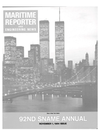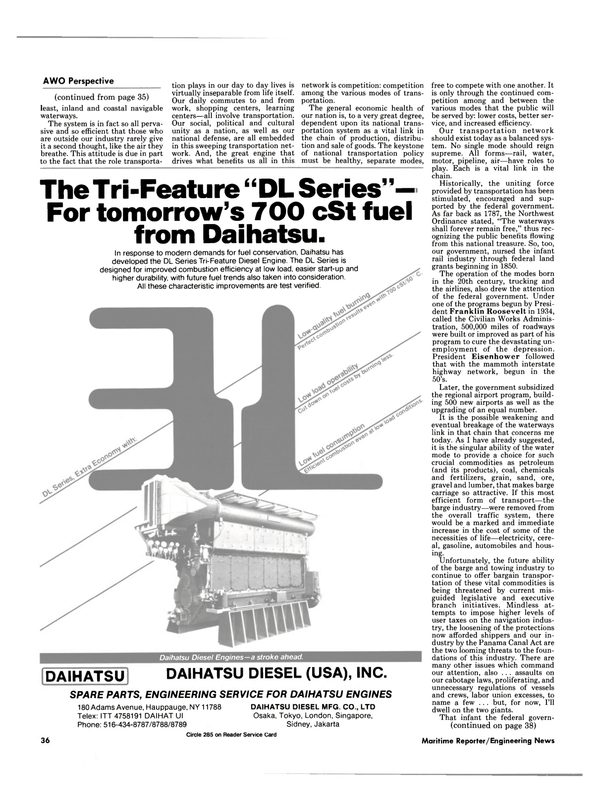
Meyer Werft Launches One And Delivers Another Passenger Ship For Indonesian Inter-Island Service
For the second time this year, a newbuilding was launched and another newbuilding was delivered on the same day recently by the Meyer Werft shipyard in Papenburg, West Germany. These newbuildings are two of a series of four passenger vessels ordered by the Directorate General of Sea Communication, Jakarta, Indonesia, for delivery between July 1983 and early 1985." These 1,737-passenger, twinscrew vessels with a cruising range of 5,500 nautical miles at a speed of 20 knots will be used for the Indonesian inter-island service. The first two ships of this series, the Kerinci and Kambuna, have been in service since August 1983 and March 1984, respectively.
In the presence of approximately 200 guests, mainly from Indonesia, the Umsini (the name of a mountain in Irian Jaya) was launched after being named by Mrs. R.A. Soerjati Roesmin Nurjadin, wife of the Indonesian Minister of Transport.
The christening and launching ceremony was followed by the delivery ceremony of the Rinjani in the outer port of Emden, at which the Republic of Indonesia was represented by the Indonesian Ambassador in Bonn, H.E. Ashadi Tjahjadi, who officially accepted the vessel.
These 13,861-grt passenger ships are built in compliance with the regulations of the Indonesian classification society KI, and under the survey of Germanischer Lloyd to the class KI + A 100 1 Passenger Vessel +SM. They have an overall length of about 472.5 feet, beam of 76.8 feet, depth from the second deck of 27 feet, and draft of 19.4 feet.
Main propulsion is provided by twin MaK diesel engines, each with a maximum continous rating of 8,700 bhp. Operating at 85 percent of mcr and 15 percent sea margin, the ships have a service speed of 20 knots. Each of the nine-deck vessels operates with a crew of 145.
For the safety of passengers and crew, 12 motor lifeboats and 38 liferafts with a total capacity of 1,412 and 950 persons, respectively, are provided on board, meeting the highest requirements of the SOLAS 1974 Convention.
The ships are divided into four fire zones. A smoke and fire detecting system is installed in the machinery spaces, cargo holds, and air conditioning rooms. A C02 firefighting system is provided in the engine rooms and cargo holds, while a sprinkler system is fitted in all other areas. In addition, fire alarms can be released manually in all areas of the ships. All are connected to a central fire alarm system located on the bridge, with optical and acoustical indicators. Manual fire door release is provided on the bridge.
The ships are divided into 13 watertight compartments, with all watertight doors closed and opened electro-hydraulically from the bridge and hand-hydraulically from above the bulkhead deck and on both sides of the doors.
The interior design is typically Indonesian and consists of incombustible materials. All paints, pictures, and other wall decorations were chosen by Indonesian architects who stayed at the shipyard during the building periods. Most of the Indonesian decorations were, however, made in Germany.
Read Meyer Werft Launches One And Delivers Another Passenger Ship For Indonesian Inter-Island Service in Pdf, Flash or Html5 edition of November 1984 Maritime Reporter
Other stories from November 1984 issue
Content
- USS Iowa (BB-61) page: 4
- Saint John Shipbuilding Appoints Snyders VP And Manager, Shipbuilding Div. page: 5
- Greller and Belt Promoted At Ashland Petroleum page: 5
- Western Gear Relocates Corporate Headquarters To South Milwaukee page: 5
- Veson Computer Systems Offers Free Literature On Shipping Programs page: 6
- Webb Institute To Hold Annual Alumni Banquet page: 6
- Giannotti Awarded Contract For Ocean Thermal Study And Conceptual Design page: 6
- McLean Urges American Shipping Community To Remain Competitive page: 6
- Allen Named Director Of MDTSCO Washington Operations Divison page: 7
- Flint & Mercer Named Senior Vice Presidents For Eller & Company page: 7
- C. Plath And Racal Marine Controls Sign Cooperation Agreement page: 7
- Sandusky Offers Brochure On Centrifugal Castings page: 7
- MarAd Awards $4,250,848 In Contracts To Improve Productivity of U.S. Yards page: 8
- Braden Winch Marketing New Planetary Hoist page: 8
- Killian Named VP Of H.O. Penn Power Div. page: 8
- Watterworth Appointed Vice President-Operations For General Steamship page: 8
- Oil Content Monitor Offered By Salwico page: 9
- Drew, DHL In Agreement For Worldwide Port Fuel Evaluation Servic page: 10
- B&W And Flight Safety Form New Joint Venture Training Company page: 10
- Hoch Promoted At Comsat TeleSystems page: 10
- WABCO Forms Worldwide Parts And Service Network page: 10
- Rothermel Named Sales Vice President For Comsat TeleSystems page: 11
- Bay Shipbuilding Awarded $l 80-Million Contract To Build Three Containerships For Sea-Land page: 11
- Cable Splicing System Lowers Shipbuilding Costs page: 12
- Evans Appointed Vice President of ODECO page: 12
- U.S. NAVY SHIP OVERHAUL MARKET First Update — Changes As Of October 1984 page: 12
- Literature Available On Sperry's New Deepwater Navigation System page: 14
- Literature Available on New Ultra-Long-Stroke Diesel From M.A.N.-B&W page: 14
- 21 New Members Elected To ABS page: 15
- Mitsubishi Kakoki Offers New Products For Solving The Fuel Quality Problem page: 18
- Promotions Announced By Consolidated Grain page: 18
- Alden Introduces New Facsimile Transceiver page: 20
- Brown Named Director Of Marketing For Seaward International page: 20
- IMODCO Awarded Contract By Esso Suez For Mooring Terminal Offshore Egypt page: 22
- WABCO Introduces New Pneumatic Control Valve page: 22
- Moody-Tottrup Brochure Available On Offshore And Marine Industry Services page: 24
- CEC Awarded $2.5-Million Contract For Ship Unloader page: 24
- Mirrlees Blackstone Moves Into New Houston Facility page: 24
- Siwertell Develops New Design For Floating Bulk Transfer Station page: 26
- Richards & Associates Named Representative For Asea Marine's Line page: 26
- Nichols Brothers Boat Builders Christens Second Passenger Catamaran page: 28
- ABS Elects Gillies Vice President page: 28
- Racor Offers Literature On Its N e w Spin-On Fuel Filter/Water Separator page: 29
- Airco Introduces New Pulsed Welding Systems page: 29
- Bender Delivers Tour Boat 'Amarya' To Nigerian Government page: 30
- Sperry Introduces New 340-mm Radar, New Autopilot, And 'Marinized' PC page: 30
- Meyer Werft Launches One And Delivers Another Passenger Ship For Indonesian Inter-Island Service page: 32
- Twin Matson Container Barges Christened At McDermott Shipyard page: 32
- Renk Offers Reference List Of Marine Gear Units Used In Naval Vessels page: 32
- Aegis Cruiser "Valley Forge' Christened At Ingalls Shipyard page: 33
- Racor Offers Literature On Its Self-Regulating Diesel Fuel Line Heater page: 33
- Renk Offers Literature On RCF Generator Gears page: 33
- Alexander Industries Named Agent For Clow/Greenberg page: 33
- Kidde Offers Free Brochure On Total Fire Protection page: 33
- The Angel Of Competition page: 34
- Mctgnavox Introduces Civil Global Positioning System page: 36
- IMODCO Awarded Contract By Esso Suez For Mooring Terminal Offshore Egypt page: 36
- Eastern Marine Signs Contract For Passenger/Auto Ferry page: 37
- Blount Marine Yard Completes High-Speed Commuter Vessel page: 41
- Free Eight-Page Brochure Available From Racor page: 41
- Browning Named Contracts And Sales Vice President For Sonat Offshore Drilling page: 42
- Valmet Delivers First Of Four Supply Vessels To Soviet Union page: 42
- MarAd Submits Final Rule For Governing Evaluation Of Bids page: 43
- New Krupp Atlas ARPA Gets British DoT Type Approval page: 43
- Wartsila Turku Yard Delivers Big Catamaran Crane Vessel To USSR page: 44
- 92nd SNAME Annual Meeting Third International Maritime Exposition page: 46
- Dyvi Heavy Lift Vessel Busy Transporting Semisubmersibles page: 47
- RFD Survival Liferaft Line Gains Davit-Launch Approval page: 47
- Peck & Hale Offers Container Lashing System Literature page: 62
- AMMCO Enters License Agreement With Damen Shipyards Of Holland page: 64
- New Pipe Connecting System Reduces Costs page: 64
- Bender Christens And Launches Cruiser "Pilgrim Belle' page: 66
- New Literature Sheet Describes Simpson's Seaworthy Panel Products page: 68
- Continental Maritime Gets $18-Million Navy Contract For Crane Ship Conversion page: 68
- Three Offshore Service Fleets Plan Merger Into New Company page: 71
- Regency Introduces New Marine Transceiver page: 71
- Hydranautics Awarded Contract By Marathon Oil For Rig-Skidding Systems page: 71
- Western Gear To Build And Sell Rademakers Epicyclic Transmissions page: 72
- New Integrated Navigation & Command System From Krupp Atlas Elektronik page: 74
- Harbormaster Offers Free 8-Page Brochure On Propulsion Units page: 74
- Korea's Samsung Shipyard Offers 24-Page Brochure On Facilities, Capabilities page: 74
- Tl Has A New Fleet Management System To Improve Vessel Operating Efficiency page: 77
- N e w Bulletin M a k e s Small S t a n d a r d Heat Exchangers Easy To Select page: 78
- Paul King Appointed Division Manager For Sonat Offshore Limited page: 78
- Deutsch Metal Offers Free Pyplok Catalog page: 78
- New Brochure Describes John Crane Maintenance Training Center page: 80
- Gulf Oil Offers Free Full Color Guide To Marine Lubricants page: 80
- Farmer Named Worldwide Operations Manager For Sonat Offshore Drilling page: 82
- Ferrous Announces FMS, System For Administering Catalyst Into Fuel Oil page: 82
- New York Port Engineers Meeting Hears Paper on Computer Uses page: 83
- DIRECTORY U.S. NAVY BUYING OFFICES page: 84
- Cummins Introduces New Premium Grade Lube Oil For Diesel Engines page: 99
- Devoe Marine Announces Management Appointments page: 100
- ABS Publishes Its First Guide For Certification Of Thrusters page: 102
- SKF Steel Introduces New Simplified Coupling page: 103
- Holmatro Offers Brochure Showing Full Product Line page: 103
- Gladding-Hearn Delivers 76-Foot Offshore Lobster Boat page: 104
- Marine Engineers Shipyard Gets Contract To Build Schooner page: 107
- GM Engines Pass Offshore Tilt Test—Literature Available page: 112
- Flexaust Announces A Major Improvement In Its Product Line page: 113
- Design Manual Available On Teleflex Remote Mechanical Valve Actuator page: 113
- Lisnave Will Continue Technical Support To ASRY In Bahrain page: 119
- Du Pont Offers Free Brochure On New "Offshore Maintenance Painting Service' Program page: 119


